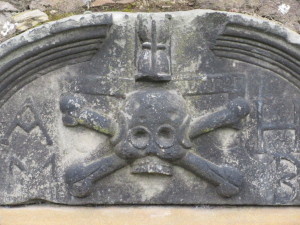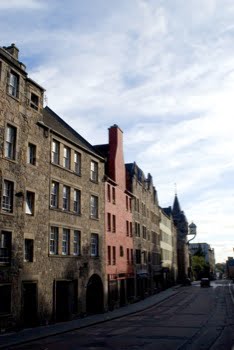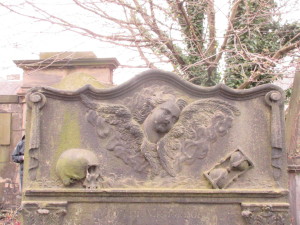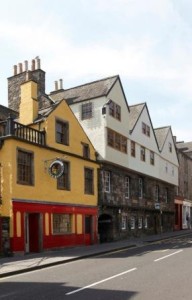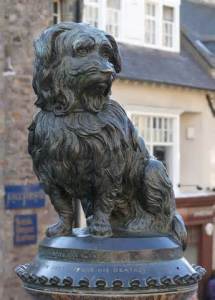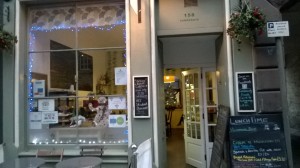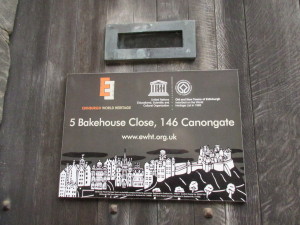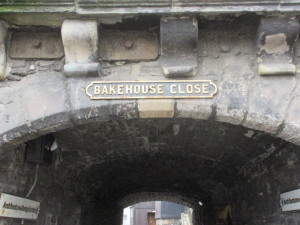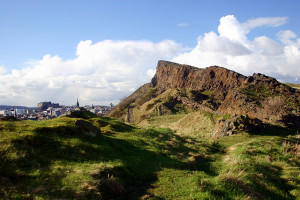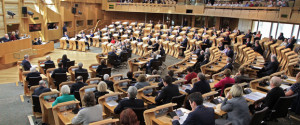The Canongate: a big story to tell
‘There’s history and there’s mystery here’
Gordon Stewart is a man with a mission. The Head of Visitor Services at the Scottish Parliament – himself a Canongatian, born in the Elsie Inglis Hospital in Abbeyhill – wants to introduce people to a part of Edinburgh that many of us overlook. We all know that the Parliament is somewhere around there; we’ve maybe even visited the Palace of Holyroodhouse – but down in the Canongate there’s much. much more. Where else, even in Scotland’s capital, can you find gardens, graves, science, poetry, meat extract and meerkats? Where else can you seek sanctuary from your debts (well, you can always try…), see the First Minister in action and visit one of the best preserved closes in the Old Town? And unlike most of Edinburgh, it’s all downhill. (You can take the bus back up).
The Canongate and Holyrood Initiative (CHI) has been set up by a collaborative group of local organisations to promote this fascinating area. CHI (with assistance from Edinburgh World Heritage) has produced an excellent free leaflet Visit the Canongate and Holyrood, which gives you a route to follow and lots of information about all corners of this burgh – for yes, it was a separate burgh, set up by King David I over 800 years ago and not part of the city till 1856. King David founded an abbey at Holyrood in 1128, after he was miraculously saved from an attacking stag while hunting in the park.
The abbey, being outwith the city boundary, became a debtors’ sanctuary; people on the run from their creditors could avoid them by setting up home within the abbey walls and working until they’d paid off their debts. In theory Holyroodhouse is still available to debtors, though the Royal Palaces might have a word or two to say if you tried to pitch your tent next to the fountain these days.
The various monarchs of Scotland were pretty keen on Holyrood; unlike that drafty old castle up the hill, the abbey had fresh air, a proper water supply, and gardens and orchards in which to exercise the royal legs. James IV was the first king to make it his official residence; after the Restoration large parts were rebuilt , but when Queen Victoria started to use it as a stopping point en route to the Highlands, it had become ‘ripe for restoration’ yet again – and she soon got to work on doing just that, sorting out the interiors whilst sending Prince Albert outside to do the rest. (He installed the Royal Mews, the carriage drive and the fountain itself). HM Queen Elizabeth II received the Pope at Holyrood in 2010, and in 2011 the palace hosted Zara Phillips’ wedding breakfast; there is also a garden party and an investiture every July.
Nowadays Holyroodhouse is one of Edinburgh’s major tourist attractions, with an extensive programme of events for all ages – this weekend there’s a Faberge Fun Day, and there are special family activities throughout the Easter school holidays. Once you’ve bought your tickets you can convert them into One Year Passes, allowing you to come back as often as you like – a particularly good deal for locals, especially those with young children (tickets must be purchased direct from the Palace to be eligible for this offer).
Zara Phillips had to get married before the party, of course – and the ceremony took place in the Canongate Kirk, just a little way up the hill. The 17th century kirk has a very distinctive style of architecture, and its graveyard is the final resting place of many famous Enlightenment figures; philosopher and mathematician Dugald Stewart can see his monument on Calton Hill from his place in the kirkyard, whilst the poet Robert Fergusson, who died at the age of just 24, was buried in an unmarked grave here – with a memorial later erected by Robert Burns, and a statue by noted sculptor David Annand installed at the front of the kirk in 2004.
Visitors often seek out the tomb of key Enlightenment player Adam Smith, posing behind the headstone as the ‘hidden hand of the market’. Don’t mock unless you’ve never been snapped with the Tower of Pisa…
Burns’ muse Clarinda (aka Agnes Maclehose) is also buried here. A new charity, the Friends of the Canongate Kirkyard is working hard to renovate the less well kept graves, and has already produced self-guide leaflets, podcasts (narrated by such modern-day Edinburgh luminaries as Donald Smith, Marco Biagi and Alexander McCall Smith) and an interactive map.
Vice-chair Eric Drake describes the kirkyard as ‘an amazing part of Edinburgh’s social history, with the best view of Calton Hill in the city’. The Friends are also keen to make the kirkyard as ecologically diverse as possible. If you’d like to find out more about the group, take a look at their Facebook page here.
Adam Smith lived at Panmure House, a rare example of a 17th century town mansion, currently undergoing restoration; Edinburgh Business School (Heriot Watt University) bought the house in a derelict state in 2008, and hopes to develop it as a world-class centre for education, events and debates. Just a short distance away is Dunbar’s Close Garden, laid out in the 17th century style by eminent biologist Patrick Geddes, who aimed to recreate the sort of garden that was typical in the 1600s, when the Canongate had many wealthy residents living in impressive townhouses.
The garden was restored to glory by the rather bizarrely named Mushroom Trust in 1978 and and donated to the City of Edinburgh, so it’s open to all. As is so often the case in the Old Town, this beautiful oasis is hidden just out of sight; take time to find it, and you will be rewarded with not only a peaceful interlude but also what has been called ‘the third best cityscape on the planet’ – a stunning view of Calton Hill and the neo-classic Royal High School. See the latter now before it becomes who knows what.
On the opposite side of the Canongate is another unexpected treat: the Museum of Edinburgh is, says City Arts Centre assistant Ernie Rossi ‘ a jewel; a whole suite of galleries with uncommonly wonderful delights, housed in a most interesting building’. There are no gadgets in this museum, which numbers amongst its treasures an original copy of the 1638 National Covenant, Greyfriars’ Bobby’s collar and bowl, and lots about Edinburgh life, from brewing to making biscuits.
Visitors, says Ernie, can let their eyes be their guide; ‘Use your intelligence and curiosity to have a dialogue with the artefacts’. And across the road from Huntly House you can find out even more about daily life in the city; The People’s Story, housed in the old Canongate Tolbooth, has everything from a bookbinder’s shop to a wartime kitchen.
Run by the city council, both museums are completely free for you to enjoy, and the Museum of Edinburgh now has a dedicated Family Activity area;
a brand new cafe, Sugarhouse@Museum of Edinburgh (whose main premises are just nearby at 158 Canongate), will open on 10th April (for the summer months) in the courtyard of Acheson House (which is, by the way, a fine example of a 17th century town house itself) the HQ of Edinburgh World Heritage Trust, who saved it from dereliction.
And now we come to Russia – yes Russia, or at least the TV version thereof. Seen those meerkats in their shop in Old Moscow Town? The advertisement was actually filmed in Bakehouse Close, right here in the Canongate. (Foyle’s War shot some scenes here too).
So next time you spot Aleksandr Orlov in the Close, be friendly; you might get some free car insurance.
It may be over 200 years since Burns and Fergusson frequented the Canongate, but poetry didn’t stop with them. Just round the corner from Bakehouse Close (thankfully not yet renamed Meerkat Land) in Crichton Close is the Scottish Poetry Library, the only poetry library in Scotland open to the public (though it’s about to close for a few months for renovation). The SPL started life with 300 books; it now has a collection of over 40,000 items, including CDs, vinyl recordings, books in Braille and large print, pamphlets, cuttings and a children’s section with bean bags on which to snuggle – and anyone can access these wonderful resources free of charge.
Although the core of the collection is everything published in Scotland by Scottish poets, there’s a huge international selection too. SPL has an extensive programme of events, exhibitions and educational outreach, and all of these will continue in other venues during the closure. Next week there’s a WN Herbert Poetry Reading (with an open stage section) at Lauriston Hall for the Refugee Survival Trust, plus events at the Botanics, Merchiston Castle School and The Blind Poet. If you’d like to support SPL by becoming a Friend, find out about the benefits here.
After all that walking about, you’re going to be hungry. Fancy some Bovril? You can probably buy this wholesome beverage somewhere in the Canongate, but in the late 1800s it was sometime Edinburgh resident John Lawson Johnston who invented the stuff, having started his experiments in a butcher’s shop at 180 Canongate. Johnston aimed to produce a nourishing drink for the city’s poor; in the process he also made himself extremely rich, eventually dying on his yacht at Cannes in 1900. Generations of Scottish football fans keep his legacy (and, in the deep dark days of winter on the terraces, themselves) alive. Bovril aside, there are numerous excellent places to drink and dine in this area, which in the 19th century had the highest concentration of breweries in the UK (all the lords and ladies having by then decamped to the New Town). The Scottish & Newcastle was the last to close its doors (the Scottish Parliament is built on its very site), but you can still see the remnants of another at The Tun – it’s now the home of Pizza Express.
Just round the corner in Jackson’s Entry is the wonderful Serenity Cafe, run by people in recovery for people in recovery and for anyone who appreciates ‘good value, good quality food in a relaxed space’. It’s a great place and well worth a visit.
There may be history and mystery (and meat extract…) in the Canongate, but there’s science too. The ‘father of modern geology’ James Hutton was another key Enlightenment figure. Hutton built a house overlooking Salisbury Crags, and it was those very rocks that helped him to calculate the age of the earth itself. Just over 200 years later, Our Dynamic Earth – a 5* visitor attraction telling the story of the planet – opened in the shadow of those same Crags.
Visitors can feel the heat of a bubbling volcano, face the chill of polar ice, or feel the earth shake beneath their feet: it’s all here. The Showdome screens films throughout the year, complete with ‘explosive surround sound’, and of course there are lots of Easter activities, and events for the Edinburgh International Science Festival. Tickets are cheapest online, and you can buy a year’s pass for less than the cost of two separate tickets: bargain! The venue is also available for conferences, birthday parties, meetings, dinners and even weddings.
From ancient rocks to new beginnings…a short walk from Our Dynamic Earth leads us back to The Scottish Parliament. The building, designed by Enric Mirrales, opened in 2004; it may be controversial but it certainly makes a statement, and it has won many architectural awards. It’s very ‘green’ too – the grass is left uncut (and sown with wildflowers) to allow it to blend into the landscape, all of the electricity comes from renewable sources, and there are specially designed and very arty bicycle racks. A rowan tree has been planted at one of the doors to protect Parliament from ‘malevolent beings’: whether it achieves this or not depends perhaps on your point of view.
And if you think the Scottish Parliament only offers debates, think again! You can certainly visit the Parliament in action – First Minister’s Questions is an immensely popular event (for free tickets see the SP website – they go very quickly – or contact your MSP) – but you can also take one of four different tours around the building, focusing on art (the Parliament has a vast collection of modern works), literature, history or the building itself, see many exhibitions (Andy Warhol, Graeme Baxter and the Great Tapestry of Scotland have all been the subjects of SP shows, and this year there will be two major photographic exhibitions), eat in the Parliament Cafe, use the free creche (whilst you’re in the building) or have a look round the shop. The Edinburgh Science Festival has a presence here too: until 30th April 2015 in the Main Hall you can see a replica of Vulcan: The World’s Most Powerful Laser, plus interactive exhibits, animations, hardware and displays. And of course it’s all free.
So next time you’re in town, take a walk down ‘The Glorious Half Mile to Holyrood’. As Sir Walter Scott apparently uttered (though he probably ‘borrowed’ it from Virgil) Sic itur ad astra or This is the path to heaven.
You’ll be surprised, entertained and educated – and you might even see a Meerkat. Don’t depend too much on avoiding your creditors though; I think HRH is probably a bit fed up with people trying that one.
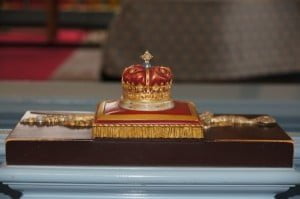
#canonGREAT
